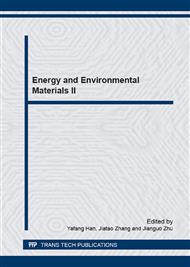p.345
p.351
p.358
p.365
p.371
p.376
p.384
p.389
p.392
Removal of Nickel (II) Ion from Wastewater by Modified Maifanite
Abstract:
The nickel ions in industrial wastewater derive from electroplating and chemical plating industry. Heavy metal ions can result in water pollution, and do harm to people’s health. Maifanite is a kind of nontoxic and harmless silicate rock mineral materials which have a certain biological activity. Maifanite porthole effect and surface effect can apply to removal of heavy metal ions from wastewater, for example, nickel ion, etc. However, natural Maifanite porous structure could be jammed by humus and sediment gradually; in order to play better adsorption performance of Ni (II) and other heavy metal ions in water, we need to adopt necessary modification treatment processes. H2SO4 was used to modify Maifanite, which prepared a high efficient adsorbent. At the same time, the removal effect of Ni (II) in water at different acid concentration, dosage, temperature, time and etc. was studied. The results showed that the Maifanite obtain better adsorption of 90% when the acid concentration was 2.5 mol/L, dosage of 50 mL, contact time and temperature of Ni (II) were 0.5 h and 30°C respectively. The above treatment has certain effect and meaning to reduce harm extent of industrial wastewater on environment and human health.
Info:
Periodical:
Pages:
371-375
Citation:
Online since:
March 2015
Authors:
Keywords:
Price:
Сopyright:
© 2015 Trans Tech Publications Ltd. All Rights Reserved
Share:
Citation:


